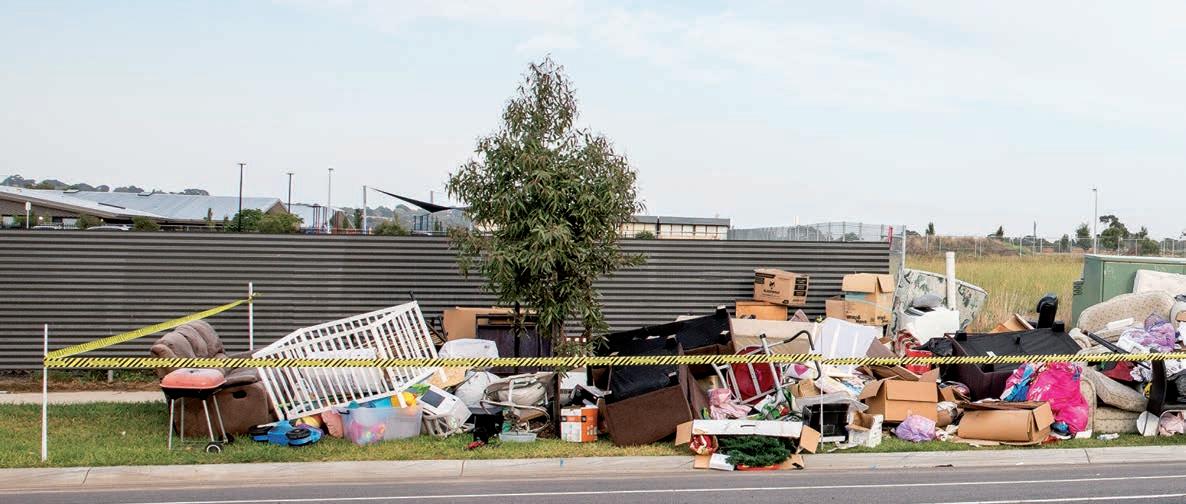
15 minute read
COUNCIL IN FOCUS
Council calls out rubbish behaviour
HUME CITY COUNCIL IN VICTORIA IS FED UP WITH ILLEGALLY DUMPED RUBBISH TURNING ITS STREETS AND VACANT LAND INTO A TIP.
Earlier this year, the council removed 40 cubic metres of dumped waste from just one street and issued fines to 17 people believed to have contributed to the mess.
Despite installing surveillance cameras at dumping hotspots and encouraging residents to call out bad behaviour, illegally dumped rubbish continues to pile up.
Hume City Mayor, Councillor Joseph Haweil shares how the council is trying to take back its streets.
HOW LONG HAS ILLEGAL DUMPING BEEN A PROBLEM IN HUME CITY?
Illegally dumped rubbish has been a major challenge for Hume City for many years, and unfortunately, several councils in Victoria are also facing the same challenge.
HAS IT WORSENED RECENTLY?
Council has seen a steep increase in illegal dumping over the past four years, particularly in the dumping of unwanted household items. There has been a noticeable increase since COVID-19 lockdown restrictions started last year.
WHAT TYPE OF RUBBISH IS BEING DUMPED AND WHERE IS IT BEING DUMPED?
The most common types of dumped rubbish that we find in Hume City are household items that don’t fit in a household bin, and construction and demolition materials.
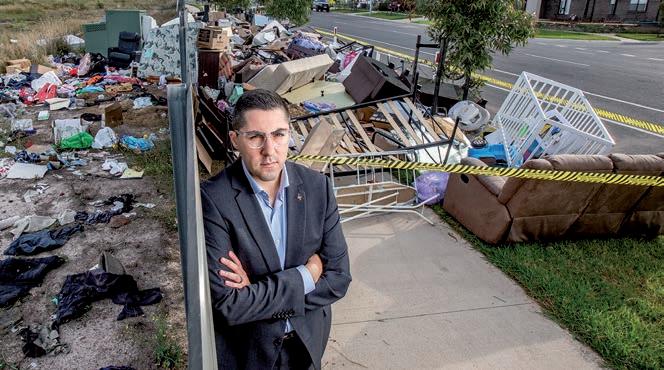
Hume City Mayor Joseph Haweil at one of the dumping hotspots.
Hume City has spent an average of $3.1 million each year cleaning up illegally dumped rubbish.

Household items and construction and demolition materials are often dumped.
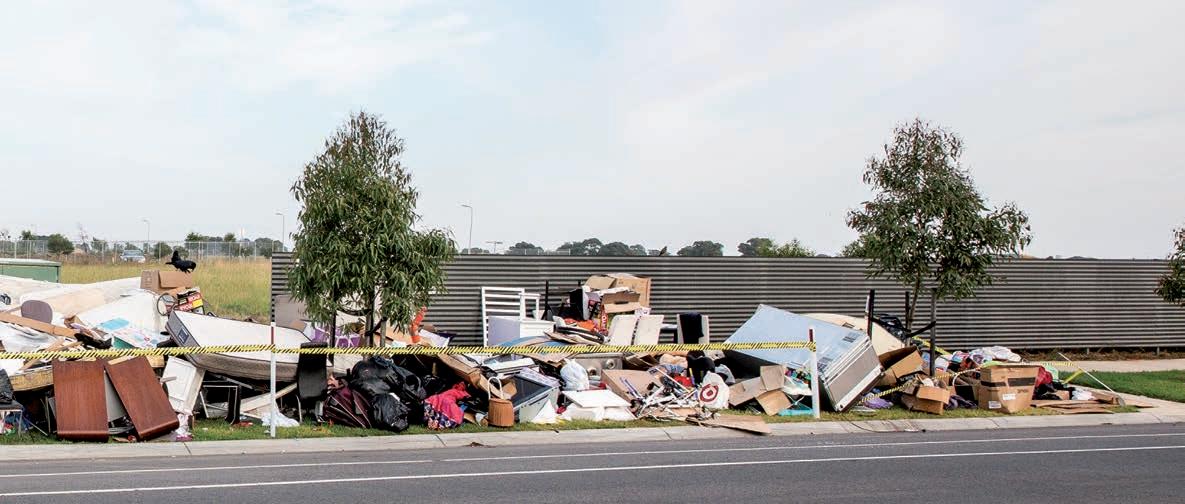
IS THERE ONE AREA THAT STANDS OUT AS BEING MORE PRONE TO ILLEGAL DUMPING?
New areas under development are subject to large amounts of illegal dumping, along with back roads and industrial areas.
WHAT ARE THE COSTS TO COUNCIL AND THE COMMUNITY TO HAVE ILLEGAL DUMPING CLEANED UP?
In the past 12 months, cleaning up illegal dumping has cost Hume City’s ratepayers an average of $3.1 million each year.
WHAT HAS COUNCIL DONE TO ADDRESS THE ISSUE OF ILLEGAL DUMPING?
A common response from residents who have been caught illegally dumping is that they don’t know what services are available to them.
To make long-term change and ensure residents are aware of their entitlements, council has developed and launched a pilot waste education campaign for the Craigieburn area which is a known hotspot for illegally dumped rubbish. The campaign aims to inform residents about their service entitlements, encourage a proactive and planned approach for residents to manage their waste, educate residents on the impact of illegal dumping and the potential consequences if caught.
The campaign launched in July and has involved: • Developing informative animations to help educate our community. • Sharing educational messages about our services and how people can dispose of waste easily for free across digital and social media, printed publications and signage in shopping centres. • Partnering with property developer,
Stockland, to display signage deterring dumping in Craigieburn. • Sending a reminder of waste service entitlements to Craigieburn residents with their most recent rates notice.
In terms of enforcement, we have also installed surveillance cameras and signage in hotspot areas around the municipality to catch offenders.
The campaign has passed the halfway mark and council is looking forward to seeing the results.
WHAT WASTE SERVICES DO RESIDENTS OF HUME CITY HAVE ACCESS TO?
Hume City Council offers a variety of free and accessible services to all residents including household waste, recycling and optional organic collection service, at-home hard waste collection service, tip vouchers and mulching days.
IT MUST BE FRUSTRATING FOR THIS TO BE A RECURRING PROBLEM.
Hume City Council continues to offer a wide range of free and subsidised services to assist with waste management so there is simply no need to dump rubbish in Hume.
Illegal dumping damages the environment, it’s an unpleasant sight in our suburbs and frustrates our residents. It also costs our ratepayers millions of dollars which could be better spent supporting our community in other ways.
TUTT BRYANT’S M&J PRESHRED 1000 MOBILE
TUTT BRYANT’S M&J PRESHRED 4000 MOBILE
WEST-TRANS EQUIPMENT’S HL 20/20A HOOK LIFT
The Metso PreShred 1000 mobile is a compact, mobile waste shredder designed for use at sites where limited quantities of waste need to be processed with considerable efficiency.
The 159kW diesel-hydraulic power unit makes the Metso1000 mobile independent of any power supply.
Because you can move it easily from one place to another, it makes an exceptionally versatile waste shredder solution that is ideal for a wide variety of needs.
HYDROSTATIC DRIVE
The M&J Eta PreShred 1000S has three different power pack options – 2 x 55kW, 2 x 75kW and 2 x 90kW – depending on the required capacity and type of material to be shredded.
KNIVES & SHAFTS
The M&J Eta PreShred 1000 is available with 4-8 rotating knives per shaft, depending on the required output size. The counter knives are
M&J PreShred 4000M mobile pre-shredder is an easily transportable waste shredding machine used in waste recycling and waste processing applications.
It can handle many types of waste from municipal solid waste, industrial and commercial waste to bulky waste.
M&J PreShred 4000M is the smaller model in Metso’s mobile preshredders family. It is available as a track-mounted (on crawlers) or a wheel-mounted (on trailer) version.
Suitable for versatile applications in transfer stations, landfill sites, composting and recycling plants, M&J PreShred 4000M is compliant to emission standards in both Europe and USA.
It performs well in extremely tough conditions and processes waste that contains unknown materials.
M&J PreShred 4000M is designed for easy maintenance and seamless uninterrupted operations.
Loading and discharge height parameters can be varied to allow optimum performance even in challenging environments.

Fabricated bin rests, billet steel bin locks and an Australian design make West-Trans Equipment hook lifts the toughest on the market.
The HL20 and HL20a hook lift is a new low-bed pedestal height model, allowing for lower clearance height and greater stability.
Keeping the lifting hook close to the rear drive when lifting improves the performance and truck stability.
The HL20 and HL20a are designed around the major truck manufacturer’s standard bogey drive, twin steer chassis LWB range and fit most without needing modification. Both fixed and articulated models are available.
Recommended for 8x4 axle configuration trucks.
The HL20 handles a minimum bin length of 4500mm up to 6700mm. The HL20a ranges from 3500mm minimum to 6700mm.
All West-Trans skip loaders are craftsmen-built in the company’s Mulgrave, New South Wales’ factory which means they can accommodate customer requests for a range of additions and modifications.
Options can include adjustable hook, inner bin locks, additional tiedown points, amber flashing beacons, tool boxes, work lights, broom and shovel brackets, tarping tower and undercover system. All WestTrans hook lifts are protected with an anti-corrosion primer base coat and two coats of high gloss colour.
All relevant Australia Design Rules are met or exceeded.
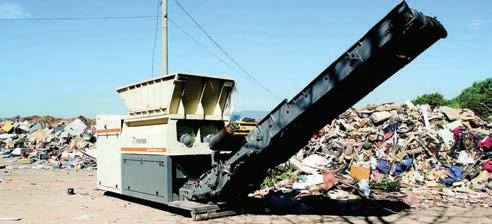
The M&J PreShred 1000 mobile is easily moved.
replaceable, and the shaft positions can be adjusted horizontally. The rotating knives are 60mm thick and made of Hardox steel.
Contact – Tutt Bryant
P 02 9780 7277 W www.tuttbryant.com.au
Contact – Tutt Bryant
P 02 9780 7277 W www.tuttbryant.com.au The M&J PreShred 4000M can handle a variety of waste types.
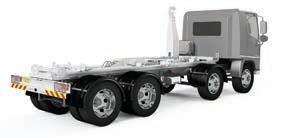
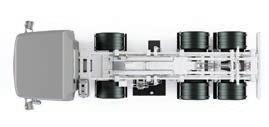
West-Trans Equipment is craftsmen-built.
Contact – West-Trans Equipment
P 1300 877 411 E sales.nsw@west-trans.com.au W west-trans.com.au
CARLSON’S LANDFILLGRADE MACHINE GUIDANCE FOR COMPACTORS
ELDAN RECYCLING’S FINE GRANULATOR FG1504
LINCOM GROUP’S ACTION TAPER-SLOT SCREEN
Poor compaction exposes a landfill site to numerous risks, including inefficient airspace use, greater settlement, and shortened cell life, all leading to lost time and money.
Relying solely on an operator’s experience, no matter how skilled they are, is simply not accurate enough to ensure these risks are adequately managed.
Introducing GPS-based machine guidance is a simple and effective way to empower operators with the information they need to work accurately to the landfill design.
Solutions such as the LandfillGrade system from Carlson, can be installed on any age, make or model of machine. The kit includes a GPS antenna mounted to the roof, along with sensors fitted to the body, and an in-cab display that give the operator a clear, visual representation of their position and distance to grade.
Benefits to introducing Calrson LandfillGrade include: •Airspace optimisation and longer cell life: Utilise available space as effectively as possible. •Increased safety and reduced environmental impact: Fewer air pockets and better stormwater management due to optimised design.
GPS-based machinery can empower landfill operators.
In-cab display guides operators to reduce fatigue, avoid hazardous areas including gas wells and reduce fuel consumption. •Consistently hit targets and track results: Eliminate rework and fulfil legislative requirements with accurate, digital reporting.
Carlson distributor Position Partners provides comprehensive support, training and consultation Australia-wide.
Contact – Position Partners
P 1300 867 266 W www.positionpartners.com.au
Eldan Recycling is one of few companies supplying equipment to the recycling industry that still primarily make its machinery in-house.
More than 1100 complete systems and 8000 individual machines have been installed worldwide, including standard and customised recycling solutions.
The research and development department works closely with customers to adapt, develop, and design solutions for their problems.
Eldan Fine Granulators are high speed, single shaft granulators for the final step in the recycling process of steel-free materials.
The Fine Granulator FG1504 is specifically designed for materials such as tyres, cables, aluminium scrap (all types), textile, plastics, and preparing them for sorting.
It is ready for connection of pneumatic material transport to ensure a dust free environment and area around the granulator.
The rotor is also designed for optimum air flow to keep the material cool during processing.
Adjustable static knives on both sides of the rotor enable a double cut of the material for optimum size reduction.
The machine features easy access for changing knives and screens. Knives can be changed in less than one hour, screens in less than 10

The Fine Granulator FG1504 is a high-speed, single shaft granulator for the final step in the recycling process.
minutes. Screens with different hole sizes are also available to ensure a flexible production.
A hydraulically operated inlet hopper provides easy access to the cutting chamber for maintenance.
Exchangeable wear parts ensure a tough machine.
Contact – Eldan Recycling - Carsten Nielsen
P +45 2149 1967 M cn@eldan-recycling.com W eldan-recycling.com
The innovative Action TAPER-SLOT Screen is designed to excel in challenging applications that conventional screens can’t handle.
Unlike standard finger screens, the TAPER-SLOT has patented lateral wedge members which prevent material from shifting laterally and catching under or wrapping around finger tips.
Wedge deflectors prevent longer, often over-sized materials from free-falling into the screened fraction, instead, they contact the formed ‘tail’ portion of the screen and are conveyed downstream for discharge with the oversize.
A combination of long stroke vibratory action and screen design provides smooth, continuous material flow and efficient separations.
A material cascade at the mid-point of the TAPER-SLOT helps turn over material and increase downstream screening efficiency.
Multiple sizes can be screened per unit and modular screen sections are easily changeable.
The TAPER-SLOT has a proven track record of reliability and performance in screening a variety of applications including construction and demolition, scrap tyres, wood waste, compost, aggregate and dirt, commercial waste, glass, plastics and metal and Refuse Derived Fuel.
Each TAPER-SLOT screen is customised to meet specific application requirements.
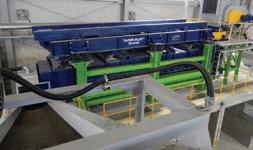

The TAPER-SLOT screen has a proven track record of reliability.
Contact – Lincom Group
P 07 3293 0888 W www.lincom.com.au
Road to recovery
ROSE READ, CHIEF EXECUTIVE OF NWRIC AND PETER OLAH, NATIONAL EXECUTIVE OFFICER OF AORA, EXPLORE THE CHALLENGES AND RISKS OF HALVING ORGANIC WASTE TO LANDFILL BY 2030.
FOGO might be a hot button topic now with enormous potential for organics to step up and help meet the National Waste Policy Action Plan target of 80 per cent resource recovery by 2030, but there are plenty of challenges and risks to manage as we head down this pathway.
Food and organics is one of the largest waste streams and an important area of focus if there is a chance of reaching 80 per cent resource recovery by 2030, says Rose Read, Chief Executive of National Waste and Recycling Industry Council (NWRIC).
“The National Waste Report 2020 showed 14.2Mt of organic waste was generated in 2018-19 with an estimated 6.85 Mt deposited in landfill,” she says.
“Halving this volume to landfill by 3.42Mt per annum will be a significant contribution to the estimated 12Mt to 15Mt of waste we need to divert from landfill annually to achieve 80 per cent resource recovery by 2030.
“Fortunately, organics are already trending in the right direction, with organic waste to landfill dropping by 4 per cent from 7.12Mt in 2016-17 to 6.85Mt in 2018-19.”
The current national organics recycling rate is about 52 per cent, however rates vary significantly from 19 per cent to 78.9 per cent across states and territories, along with their commitments to increasing organics recovery.
The Federal Government also has organics in its sights, with the announcement of a $67 million Food Waste for Healthy Soils Fund in the 2021-22 budget, to be matched 1:1:1 by state and territory governments and industry participants to build new and/or upgrade existing organic waste processing infrastructure and capacity.
Peter Olah, National Executive Officer, Australian Organics Recycling Association (AORA) welcomed the announcement of the fund and said that while the aim is to increase the food and organic waste recycling rate, there are several challenges associated with the organics recycling sector.
“Government modelling indicates that through this fund, up to 3.4 million tonnes will be diverted from landfill. However, funding is also contingent on several policy measures being considered.
“Around 30 per cent of Australians have access to a full Food Organics Garden Organics (FOGO) service, and while trials are taking place across metropolitan and regional councils with
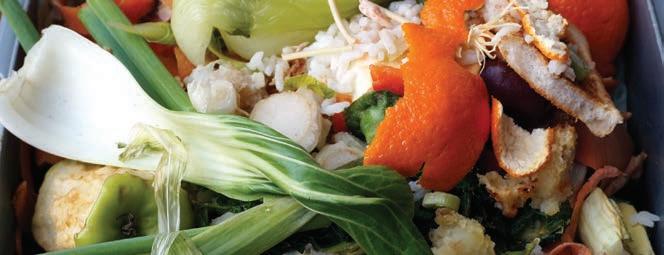
PROPOSED POLICY MEASURES OF THE CONDITIONS OF FUNDING UNDER FOOD WASTE FOR HEALTHY SOILS FUND
1. Harmonise kerbside Food Organics and Garden Organics (FOGO) inputs including the development of nationally consistent inclusion and exclusions lists. 2. Deliver consistent education initiatives to prevent contamination in kerbside FOGO bins.
3. Work with the Australian Government and industry to update Australian
Standard 4454: composts, soil conditioners and mulches. 4. Work with the Australian Government and industry to implement an industry-led certification scheme for recycled organics products fit for specific end-market uses. 5. Work with local government associations to ensure organics waste processing contracts. 6. Incentivise the delivery of low contamination feedstocks to organic waste processors, and prioritise the development of high-quality recycled organics products.
Organics is trending in the right direction in the push to reduce waste going to landfill.
State / Territory Organics recycling rate Organics to landfill (kt) Policies and priorities
NSW 57.1 % 1713 NSW Waste and Sustainable Materials Strategy 2041 • Halve the volume organics to landfill by 2030 • Mandating source separation of food and garden organics from all NSW households by 2030 • Net zero emissions from organics in landfill by 2030 VIC 49.6% 1839 Recycling Victoria 10-year policy and action plan • Halve the volume of organic material going to landfill between 2020 and 2030, 20 per cent reduction by 2025 • Every Victorian household has access to food and garden organic waste recycling services or local composting by 2030 QLD 38.3% 1745 Waste Management Resource Recovery Strategy • 25 per cent reduction in household waste by 2050 • 90 per cent of waste is recovered and does not go to landfill by 2050 • 75 per cent recycling rates across all waste types by 2050 Draft Queensland Organics Strategy 2022-2032 (Public consultation until 1 November) SA 78.9% 289 South Australia’s Waste Strategy 2020-2025 • Increase kerbside organics (food and garden) diversion to 75 per cent • Zero avoidable waste to landfill by 2030 WA 33.7% 877 Waste Avoidance and Resource Recovery Strategy 2030 • 20 per cent reduction in waste generation per capita by 2030 • Increase material recovery to 75 per cent by 2030 Tas 37.8% 173 Draft Waste Action Plan • 25 per cent reduction in volume of organics waste sent to landfill by 2025 and 50 per cent reduction by 2030 ACT 68.2% 103 ACT Waste Management Strategy • Increase recovery rates to over 90 per cent by 2025
NT 19% 106 No specific targets
States and territory recycling and landfill levels; priorities for food and organic waste recycling
varying degrees of success, there are still several challenges in implementing FOGO, and it will not be a silver bullet.
“Not only has householder participation been an issue, contamination at the source is also a big concern. There is real need for the harmonisation of what can go in the green bin plus an extensive nationally consistent education campaign so that households know exactly what to put where.
“Access to local waste infrastructure, ideally within 90 minutes of the collection point, is also imperative, as the costs involved in processing FOGO are a big consideration in the success of council managed programs. This is in part why we have seen greater success of FOGO in regional areas.
“Increasing FOGO recycling within local councils is also not going to be singularly responsible for getting organics recovery to 80 per cent by 2030. Areas like commercial organic waste will also need to be included,” says Peter.
Rose adds that alignment of state and territory regulations on facilities processing food and organic wastes with what is accepted in green bins will also be important to help reach the proposed resource recovery targets.
“To get to 80 per cent resource recovery, we need to recover a further 3.4 Mt of organic material.
“The National Waste and Recycling Industry Council is, with the assistance of MRA Consulting and funding from the Department of Agriculture, Water and the Environment, currently mapping and assessing the impacts of recovered material specifications for sorting, primary and secondary processors including food and organics. The project will importantly identify minimum specifications and recommend actions on interventions throughout the resource recovery value chain from collection through to end use to enable greater resource recovery and reuse.
“Ultimately, creating more certainty for end users on the quality and supply of recovered materials gives industry more confidence to invest and build capacity in organics resource recovery necessary to halve organic waste to landfill by 2030,” Rose says.










